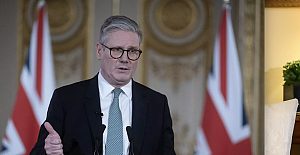AVRUPA-Türkiye celebrates 100th anniversary of its Victory Day on Tuesday, when it succeeded in Great Offensive under Ataturk’s leadership against Greek forces.Türkiye remembers Great Offensive: One of the greatest military victories in history. The resounding defeat of the occupying Greek army at the hands of Turks in the Battle of Dumlupinar in 1922.The Great Offensive -- one of the greatest military victories in history -- was launched by the Turkish Armed Forces on Aug. 26, 1922 under the leadership of Mustafa Kemal Ataturk, the founder of modern Türkiye, and ended on Sept. 18 that year.According to information compiled by Anadolu Agency, in 1919, the victors of World War I -- also known as the Entente Powers -- landed in present-day Türkiye, occupying large swathes of land based on the provisions of the recently signed Armistice of Mudros.

As British, French, Italian and Greek warships anchored in the Turkish Straits, French troops took over the region around Adana -- now in southern Türkiye. British soldiers entered Urfa and Maras further east as well as Samsun and Merzifon in Black Sea region. The Italians occupied large strips of the Mediterranean coastline including Antalya and other southwestern Anatolian cities.On May 15, 1919, the Greek army landed in Izmir with the permission of the Entente Powers, triggering what would become a full-fledged uprising and campaign against the rule of occupying forces in the country.Forming the National Forces (Kuvayi Milliye) as a means of armed resistance against the invaders, Turks knew that there were only two possible choices - either surrender to the occupation forces or fight against them.The Turkish Grand National Assembly was launched in Ankara in 1920, as the occupiers focused their repressive policies on Ataturk and his colleagues and the Turkish Army moved to the western front. The following year, Turkish soldiers would repel Greek forces that advanced within 70 kilometers (43.5 miles) of the young parliament.After roughly one year of preparation, Commander-in-Chief Ataturk launched the Great Offensive on Aug. 26, 1922 to expel the enemy.Moving further west, he commanded the battle with top commanders Fevzi Cakmak and Ismet Inonu.At dawn, the offensive began with artillery fire, and Turkish soldiers pushing forward seized Tinaztepe, Belentepe and Kalecik Sivrisi near the town Afyonkarahisar, which the Turkish army would seize on Aug. 27.On the night of Aug. 29, the commanders made a situation assessment and agreed to act immediately and conclude the attack in a short time.Ataturk ordered the Turkish army to move on to western Kutahya on Aug. 30 in a decisive blow to the Greek troops in Anatolia.Following the victory, Ataturk, Cakmak and Inonu set to sweep the remaining Greek soldiers out of Anatolia in an offensive on the city of Izmir on the Aegean coast.

"Armies, your first goal is the Mediterranean. Forward!" Ataturk ordered the army, which would move out from western Kutahya on Sept. 1.
On Aug. 27, the Turkish Army liberated Afyonkarahisar from the Greek army, Kutahya on Aug. 30, and Izmir on Sept. 9.Two years later on Aug. 30, 1924, Ataturk attended the groundbreaking ceremony of the Martyr Sancaktar Soldier Monument.Addressing the audience, he said: "The Turkish nation has once again engraved this truth in the bosom of history with a steel pen with the victory it has won, the power it showed and its will.”


 Prime Minister Keir Starmer's 2025 Easter message
Prime Minister Keir Starmer's 2025 Easter message After Nesil Caliskan a by-election will be held in Jubilee ward in Enfield
After Nesil Caliskan a by-election will be held in Jubilee ward in Enfield Publishing the analysis, Labour’s Cllr Ergin Erbil said Everybody in Enfield deserves basic rights
Publishing the analysis, Labour’s Cllr Ergin Erbil said Everybody in Enfield deserves basic rights Gaza-Israel conflict Statement from Cllr Ergin Erbil, Leader of Enfield Council
Gaza-Israel conflict Statement from Cllr Ergin Erbil, Leader of Enfield Council The European Union called on Turkey to uphold democratic values
The European Union called on Turkey to uphold democratic values Turkish citizens in London said Rights, Law, Justice
Turkish citizens in London said Rights, Law, Justice The Council of Turkish Cypriot Associations Geneva response letter
The Council of Turkish Cypriot Associations Geneva response letter Sustainable Development and ESG, Will This Become the Course for Turkic World
Sustainable Development and ESG, Will This Become the Course for Turkic World The 'Prince of Paris' has impressed in his first EuroLeague season
The 'Prince of Paris' has impressed in his first EuroLeague season Saran Media And Euroleague Basketball Extend Media Rights Partnership for Four More Years
Saran Media And Euroleague Basketball Extend Media Rights Partnership for Four More Years Will Rangers be Jose Mourinho’s next victim?
Will Rangers be Jose Mourinho’s next victim? Jose Mourinho's Fenerbahce face Rangers on Thursday
Jose Mourinho's Fenerbahce face Rangers on Thursday Barclays has become the biggest UK lender so far to cut mortgage rates
Barclays has become the biggest UK lender so far to cut mortgage rates THE SPRING STATEMENT EXPLAINED, UK ECONOMIC OUTLOOK AND GROWTH FORECASTS
THE SPRING STATEMENT EXPLAINED, UK ECONOMIC OUTLOOK AND GROWTH FORECASTS Launch of Made in Enfield gift shop to celebrate local artists and designers
Launch of Made in Enfield gift shop to celebrate local artists and designers Trial used smart Wi-Fi sensors for live building occupancy data to optimise
Trial used smart Wi-Fi sensors for live building occupancy data to optimise















